EA SPORTS College Football 25 Releases Gameplay Deep Dive Gridiron Notes
PRE GAME
CAMPUS IQ encompasses the overarching concept that has built gameplay to be what it is today. With that said, College gameplay was built on these three fundamental pillars: "All 22+", "134 ways to play", and "Stories of Saturday".
- "All 22+" highlights the importance of individual players and their unique abilities. It emphasizes the differentiation in talent between the best and worst players in college football.
- "134 ways to play" From day one our message was ‘every team is somebody's favorite team’. Properly representing offensive schemes from Air Force triple option to the Air Raid at USC was of the utmost importance to us.
- The final pillar, "Stories of Saturday", seeks to encapsulate the raw emotions of these student athletes as they perform under intense pressure in hostile environments. A true freshman is going to respond differently compared to a Senior, so getting this right was really important.
Bringing all of these together would ultimately have us landing arguably the most important aspect of College Football which is wide open gameplay.
STICK WORK
From the start, one of our primary objectives was to capture the authenticity and wide open gameplay of college football. We studied and tried to recreate the explosiveness of current and former College Football legends. The result is a game that allows you to not only play North and South, but also East and West. Thus unlocking a whole new level of excitement to the game. However, we didn't stop there, we introduced all-new specific run styles for the different archetypes in College Football 25. This will provide a more in-depth and personalized gaming experience, allowing players to mimic the styles of their favorite athletes or create their own unique approach to the game.
WELCOME TO WEAR AND TEAR
Wear and Tear is a feature that takes the football gridiron to an unprecedented level of realism. This feature ensures every hit matters and not all hits are created equal. Wear and Tear is a brand new and unique damage system that adds a whole new layer of depth and strategy to your gameplay and roster management. This is reflective of what we see on Saturdays.
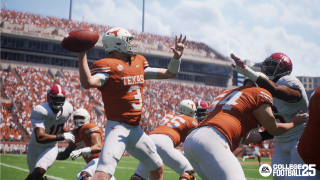
Wear and Tear is designed to simulate the real-world effects of fatigue and damage on a player's performance. It operates on a play to play and game to game basis. If your quarterback has thrown the ball 40+ times in a game and has taken some shots, don't expect him to be at 100% the following week in Dynasty or Road To Glory. Subtle gameplay components such as getting the ball out early, covering the ball, and just getting out of bounds will be as important as ever. Wear and Tear is on for ALL 22 players on the field!
SO HOW DOES IT WORK?
Every limb and body part of a player is linked with unique attributes. For instance, if your quarterback's throwing arm receives a significant hit, you'll notice a decrease in your throw power and accuracy. Similarly, damage to the legs will impact a player's change of direction and acceleration, making every movement feel slower. Each body part degrades at a different rate and the player’s toughness rating plays a critical role into how much damage is applied on a given hit. The more damaged a body part is, the higher the chance and severity of injury.
DOC, I'M HURT.
Recovery is also a critical part of this feature. Players will regain health when they are not on the field, during time outs, at halftime, and between weeks. However, be cautious of your players' workload. The worse a body part is damaged, the slower it recovers. A player can only recover a limited amount of damage during a single game.
This encourages strategic planning and management of players to ensure optimal performance. When it comes to management, outside of the quarterback and offensive line, teams will substitute around the fatigue of a player or banged up body part. If a player gets really banged up on a given play, expect him to sit a play or two, or maybe more. Later in the game the expectation is that the player will have to tough it out.
WHERE CAN I SEE IT?
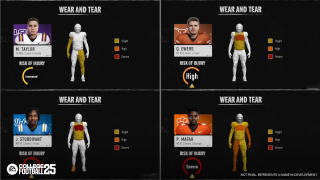
- Player reticle - Left side Wear and Tear bars, right side fatigue. Note, the bars depleting only represent the most hurt body part.
- Depth chart - Here, you can see a Wear and Tear panel on the bottom right of the player card as well as the total an attribute is decreasing in the spreadsheet.
- Coach Vision - Hold LT+RS down to see the Wear and Tear status of your entire team.
- Picture in Picture (PIP) in the play call menu.
- We've added a ton of 'Wear and Tear' get-up animations. After a player is banged up, you'll see a variety of animations for a given body part, depending on the severity.
- You can also manage your players' Wear and Tear in the Dynasty player card.
CHANGING THE GAME
With these changes, Wear and Tear will add new depths to players' gameplay, more than ever before. Up until now, aside from the risks of throwing an interception or fumbling, what have been the impacts of throwing the ball 40-50 times a game? Now, gameplay decisions come with physical consequences for your virtual players, adding another layer of authenticity and balance to the game. It's not just about the immediate win anymore; now you have to consider long-term health and performance of your team.
With the introduction of Wear and Tear, Fatigue has been completely overhauled. Whereas Wear and Tear accounts for physical impacts, Fatigue is primarily a conditioning feature, designed to provide more realistic snap counts at the College level. It's something to pay attention to on a drive-to-drive basis. Let's say a running back gets 3 consecutive carries for positive yards. You may notice them huffing and puffing in pre-play. On a subsequent carry, they'll likely come out of the game. However, recovery has been changed to where it'll likely be for only a single play, so they can catch their breath and get right back onto the field.
THE OPTION GAME
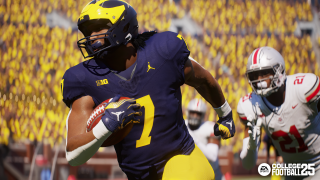
The Option game is a fundamental part of College Football, and we've made a thorough effort to add authenticity, depth, and balance. The first thing we targeted was to make the mechanic mirror the real-life quarterback and running back exchange. In an actual game, the quarterback places the ball in the running back's belly, with the intent he's going to hand it off. However, if the read key comes down, he pulls the ball. This is now replicated in the game with the 'A' or 'X' button functioning as a pull/keep button.
The changes to the pull mechanic simplifies your reads while also making RPO’s much more usable. If you don’t touch anything, the quarterback will simply hand the ball off to the running back. In an RPO scenario, if you want to bail from the read and run, press A. If you want to hit the receiver, you can simply press that receiver's corresponding button immediately to throw.
Looking to keep the ball with the QB on an RPO? The type of RPO dictates whether you can (Read/Peek) or can’t (Alert/Glance).
We've made adjustments to differentiate pitch strength. Now, a quick tap will execute a quick pitch, while holding down L1/LB will result in a strong pitch. A quick tap for a swift pitch, useful in tight spots. However, it might not hit the pitch back in stride.
▪︎ Holding down L1/LB for a strong pitch, suitable when there's ample space between you and the approaching defender. It requires more time but offers precise accuracy and velocity.
▪︎ Fake pitching is back, activated by double tapping L1/LB.
New control around when the quarterback will branch out of 'option movement' has been added as well. If you hold RT/R2 when you're a couple yards past the line of scrimmage, you'll branch into standard ball carrier movement. Use this when you've got the edge and decide to try and take it to the crib with the quarterback.
We've also added a range of new animations, including a comprehensive set of pitch animations and pitch catches. We've also introduced new pitch out of tackle animations in this year's title.
The defense has also seen some significant upgrades:
New AI logic has been added for the Read and Pitch keys, including new "Read Key" animations. Read Keys now consider more realistic contexts when deciding to crash or stay home. For instance, they're more likely to stay home and play the quarterback when on the wide hash marks. Conversely, when the offense is close to the first down, they'll play the dive back more often.
Pitch Keys now exhibit more varied behavior, with the ability to bluff whether they're playing the quarterback or running back.
We've introduced new coach adjustments as well. Rather than a single "Option Defense", you can now instruct your Read and Pitch key separately on how to defend.
These adjustments aim to offer a more authentic and immersive gameplay option. We hope you enjoy the new and improved option game.
SHELLS, AND I’M NOT TALKING ABOUT TURTLES.
Football problems require football solutions. With the removal of base alignment, we wanted to put our time and effort into improving alignment, along with giving players the ability to disguise your coverages. This is the addition to the chess match that our core fans have been asking for.
In play call, use RS while in formation view to command your secondary to position in a range of cunningly disguised looks. These can range from a high pressure Cover 0 blitz to a backed off Cover 4 look.
But the excitement doesn't stop there! Before the snap, you also have the option to showcase a single high or two high, depending on the formation you've chosen.
Unleash your creativity with these options, just like real-life coaches, to confuse opposing quarterbacks. But tread with caution! If a defensive back has low Composure, there's a risk he might mess up the disguised look.
ABILITIES
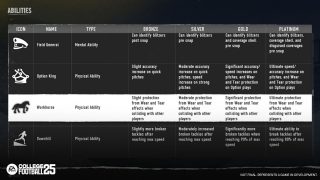
In College Football 25, we are introducing 80 abilities, the majority of which are completely new to the football gaming space. These abilities are purely situational boosts, and there are no guarantees. Abilities are categorized into two groups: physical and mental. Each of these groups is further divided into four tiers: bronze, silver, gold, and platinum. The most a player can have at any given time is five physical and three mental abilities.
Our aim is to provide players with increasing depth as they progress through these tiers. For instance, consider our new Grip Breaker ability under the physical category. This ability bolsters a defender's capability to disengage from a block. At the bronze and silver tiers, this ability is only applicable during run plays. However, at the gold and platinum levels, it also applies to pass plays, with its effects significantly amplified. Another important note to make here is that the abilities a player can have is solely determined by their archetype. Mental abilities on the other hand are dictated by the position of the player.
While creating abilities, we kept gameplay balance at the forefront of our development. A perfect example of this is the new "Pocket Shield" ability. This progressively makes offensive linemen hold blocks better on standard pass plays. However, even at the Platinum tier of this ability, it doesn't apply if the distance to the first down is more than 10 yards. So, you’ll have to stay on schedule to reap the benefits. Lastly, it's still possible for a linemen to lose even at Platinum tier.
Though this will be expanded upon later in the upcoming Dynasty deep dive, we have introduced Coach abilities with gameplay effects. These abilities will have significant impacts on major features such as Confidence and Composure, Home Field Advantage, and play styles, just to name a few.
PRE SNAP RECOGNITION
Can you see everything at the line of scrimmage like an experienced senior? What about the freshman playing on the road in front of a hundred thousand screaming fans? We have introduced a new Pre Snap Recognition feature designed to bring a level of clarity to the line of scrimmage that reflects the experience level of the player controlling the game. For instance, a freshman player may not be able to identify who is coming to blitz or what the shell is at the line of scrimmage compared to what a seasoned senior would recognize.
Our new system also takes into account player and coach abilities, home field advantage, and our new coverage shells, which I will talk about later, all of which impact what a player can see at the line of scrimmage.
WHAT ABILITY DO I NEED?
The Field General ability is what brings all of this together. Here's how it works:
Bronze Tier - Blitzers are highlighted, but only after the snap. This gives players a basic level of awareness but requires them to react quickly.
Silver Tier - Players can spot blitzers before the snap, but only if they're close to the line of scrimmage, and only for a brief moment. This gives players a slight edge and allows them to plan their moves with a bit more foresight.
Gold Tier - Unveils a coverage shell momentarily, giving players a glimpse into the defensive strategy.
Platinum Tier - Allows players to see even disguised shells, albeit briefly. This is designed to ensure that the defensive player can make strategic adjustments in response.
The Pre Snap Recognition feature adds a new dimension to gameplay, rewarding players who can quickly analyze and adapt to the evolving game situation on the field.
CONFIDENCE AND COMPOSURE
In College Football 25, the game isn't only about who has the most skilled players on the field, it's also about who can maintain their composure in high-pressure situations. Confidence and Composure is about moment-to-moment gameplay, reflecting the real-life ups and downs of these student athletes as each play unfolds. Just like we see on Saturdays, players can get 'hot' or 'cold' depending on the outcome of each play.
Experience plays a critical role in Confidence and Composure. A freshman player will have more volatile swings compared to a seasoned senior. As the crowd level increases, the effect on players' confidence increases progressively. This emphasizes the importance of composure in the digital gridiron, making it a crucial factor to consider for every play, and every game. No different than what we see on Saturdays with a young starter, it’s important to control the game and keep the chains moving.
In the heated atmosphere of a rivalry game like “The Game”, the stakes of maintaining composure are even higher. Events such as scoring touchdowns can lift the morale of your entire team, while individual achievements such as a pass breakup can significantly boost the composure of the player who made the big play.
It's important to note that composure is highly individualized, driven by a player's archetype. For instance when your player starts to “cook”, a Scrambling Quarterback will have improved ball security, while a Field General will benefit from improved throw accuracy.
Additionally, players can have unique Mental abilities that influence their Composure. These abilities can even affect their teammates for that position group. Consider the 'Legion' ability, which increases the confidence of other defensive backs when that player gets an interception. Take note, these Mental abilities are lost anytime a player goes 'cold', making the management of Confidence and Composure even more essential.
I will leave the heavy details for the Dynasty blog, but your coach abilities also play an important role in Composure. The effects are similar and remind me of when USC, led by a true freshman quarterback, went into The Horseshoe and beat Ohio State in 2009.
COACH VISION
This is a real-time, pre-snap information system designed to quickly provide you a detailed overview of these features when holding the left trigger.
Wear and Tear - This calls out the most damaged body part on a player.
Composure and Confidence - Our dual-sided bar system provides real-time insights into your player's performance: a red bar suggests your player is starting to cook, while a blue one indicates he’s getting cold. If a red flame icon or a blue snowflake symbol appears, it signifies that your player has reached the maximum in their respective area.
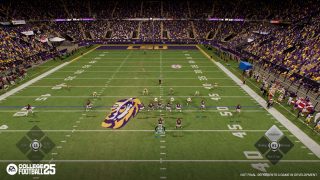
Abilities - This highlights player abilities on both sides of the ball.
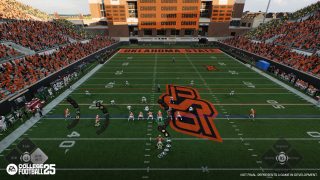
Match ups - While the idea of showing matchups is not new, we have reworked the formula to make this easily accessible and straight forward for you. This is now color-coded for ease of understanding: green for a favorable match-up, yellow for an even one, and red for a disadvantage. This system enables you to quickly assess the situation and adjust your game plan accordingly.
HOMEFIELD ADVANTAGE
Winning a football game at the Division 1 level is tough, winning on the road is even tougher! Every Saturday, we witness the significant impact that home field advantage plays in determining the game's outcome. On the virtual gridiron in EA SPORTS College Football 25, that will be no different.
Firstly, we aimed to pay off and differentiate the top environments in college football. This differentiation involved two core elements: audio and in game modifiers. Modifiers are effects that disrupt your gameplay both pre and post snap. For instance, you might experience squiggly lines, play art appearing incorrectly, audibles and hot routes failing to register at higher rates, or receiver icons fading in and out during a crucial moment of your game.
Next, we considered the critical elements of confidence, composure, and player experience. As noted above in the Confidence and Composure section, we wanted to ensure that these elements were factored into how much the hostile environments impacted you, both pre and post snap. This allows for a more immersive experience and adds another layer of strategy to gameplay. With the limited ability to communicate on the field, the initial, correct, play call will be as important as ever.
In addition, we decided to pay homage to the classic '06 version of the game by reintroducing a similar screen shake, Stadium Pulse Meter, and allowing you to tell the crowd to ‘Get Louder’ by flicking up on the RS. Our audio team really helped bring Home Field Advantage to life with their new stadium mixes. This nostalgic feature not only adds a touch of authenticity, but it also intensifies the moment, making you feel right in the heart of the action.
It's also important to note that the Home Field Advantage (HFA) only impacts the visiting team. Just like in real life, this feature is entirely situation-based. Staying within manageable down and distances is vital to successfully moving the ball down the field. As the game situation gets tougher, the crowd noise intensifies. The louder the crowd gets, the higher the modifier and composure hits. This is designed to accurately reflect the real-life dynamics of playing in a hostile environment and further adds to the immersive gaming experience.
PRE PLAY CONTROLS
This year, before each snap, you'll notice several enhancements designed to amplify the strategic gameplay. Hot routes have undergone a revamp, providing all players with access to 12 unique routes. For instance, the new "Bang 8" route has been incorporated into the Outside WR tree. The entire route tree is readily available for all Quarterbacks without the need of an ability.
Defensively, the risk factor associated with Run Commit has been toned down as well. Traditionally, the risk was conceding a touchdown if the offense opted for a pass, with the reward potentially being a tackle for loss. Now, this mechanic only affects defenders positioned in the box.
Lastly, we're introducing 'Custom Stems,' a new feature that allows you to adjust the distance of a receiver's route. While hot routing, press and hold L1/LB to start adjusting. Move LS to modify the distance by a single yard, or the D-Pad for alterations in 5-yard increments. You can see the route update in real-time. Simply release L1/LB to confirm your settings, and you're all set.
REVAMPED PASSING
Quarterback, the iconic position in football. Our main objective in the pass game was to hone the art of layering the football. This includes everything from dropping the ball in the bucket to your tight end between the linebacker and free safety, to throwing a bullet on the twelve yard dig route. These new trajectory changes really allow you to throw the receiver open.
To accomplish this, we increased the variance of left stick pass lead intent, changed our inaccuracy miss locations, and overhauled our passing trajectories. The biggest change you will feel immediately is how we evolved the concept of 'Throw Power'. Now, 'Throw Power' doesn't simply refer to the distance of the throw, but how hard you can throw it. You often hear color commentators discuss a quarterback's arm strength in the context of 10-15 yard bullets on hook and dig routes rather than 60+ yard throws.
While these enhancements are exciting, it is important to maintain balance. For years, players have been able to hold a bullet pass with little to no consequences. However, in this new system, the distance of the throw and the quarterback's attributes and abilities will affect the accuracy of a bullet, potentially resulting in accuracy penalties.
On the start of a pass, you will notice three colors: blue, yellow, and red. The sizes of these sections depend on your quarterback's attributes, abilities, the throw distance, and other factors that impact accuracy such as being pressured, back foot, on the run, etc. Landing in the blue increases the chances of a safe, accurate ball, while landing in the yellow could mean more uncertainty from your ideal target. Red areas indicate potential inaccuracy. The longer you stay in the red, the greater the penalty. Keep in mind that not all red sections are equal. Quarterbacks with weaker arms or low accuracy ratings will have larger red sections. No different from real life, trying to push the ball downfield consistently, with a Quarterback who has a weak arm, is not a great move.
This new and improved mechanic adds an engaging dimension to the game, distinguishing the digital signal callers in a unique way.
We have made significant enhancements to the pump fake mechanic. Now, when you're playing with a pass meter, the meter will appear over the receiver you are pump faking to. It's no longer necessary for receivers to execute a double move for defenders to react in that direction. We have worked on improving the defenders' reaction to the pump fake, in terms of the angle they take, the duration of their reaction, and more. These improvements add another layer to the passing game.
INTRODUCING THE SWITCH STICK
Have you ever found yourself making adjustments to defend your opponent’s passing game? All to try and stop the same pass plays from being used repeatedly against your defense. Get ready for control you’ve never had. We’re introducing the Switch Stick. A simple, yet powerful tool to make defense switching more compelling.
When you’re lurking in pass coverage, flick the right stick. This will directionally switch you to other coverage defenders according to the direction of your flick. Thus allowing you to play multiple levels of the field in an instance.
We know the pain of getting caught on your defensive line while trying to make adjustments. So additionally, when in a pass rush situation, press LS+B/O to switch directionally. What about the hit stick? No worries here, once the quarterback has thrown the ball or crosses the line of scrimmage, the right stick turns back into the hit stick.
The defensive game has changed from here. Enjoy.
PLAYBOOKS AND TEAM PLAY STYLE
This year over 1,500 new plays, more than 50 formations, along with 134 team playbooks have been created to reflect current offensive and defensive trends in the sport. In addition to team playbooks, College Football 25 also includes 10 non-team playbooks. These are based on a variety of play styles such as Air Raid, Multiple, Pistol, Power Spread, Option, Pro, Run & Shoot, Spread, Spread Option, and Veer & Shoot. These playbooks can be customized and saved as a custom playbook, adding an extra layer of strategy to the game.
Staying true to the theme of player control, a brand new type of Trick Play will debut: the "DIY Reverse". In these plays, you decide whether to hand off to your teammate using L1/LB or keep the ball and run. This introduces exciting plays like the "HB Direct DIY Reverse", designed to keep the defense on their toes.
The game action picks up with the addition of trick plays including Double Pass, Reverse, Reverse Pass, and Reverse Flea Flicker. A note to consider is that when running any given trick plays, the defense will adapt making these play calls a much riskier proposition.
A new "Glance" RPO play type has been added, giving players the ability to read a Safety to the side of the Glance route, which is a short Post. This year's game is filled with RPO plays. Consequently, we recognized the need to enhance the defense's abilities to counter them. In the majority of defensive alignments, defenders who are positioned away from the run action will prioritize their pass responsibilities. Additionally, defenders have been designed to be more aggressive in fending off blocks from incoming receivers. On top of that, run fit defenders are now capable of responding to the run action more rapidly, enabling them to come downhill and make the stop.
When it comes to attention to detail, we didn’t stop there. You will see the popular "Wide" formation/splits from teams such as Oklahoma and Tennessee which are spread further out than traditional formations, a characteristic of the Veer & Shoot play style.
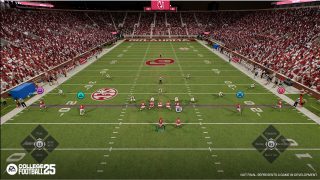
The Flexbone option offense is also introduced, featuring base plays such as Triple Option, Midline, Rocket Toss, Counter Option, and Zone Dive.
On the defensive side of the ball, the playbooks assigned to teams include the 3-2-6, 3-4, 3-4 Multiple, 3-3-5, 3-3-5 Tite, 4-2-5, 4-3, 4-3 Multiple, and Multiple.
TEMPO GAME
In order to replicate the quick-paced nature of College Football, we have introduced several modifications prior to the snap. These include "No Huddle" and a new "Turbo" tempo type, both aiming to speed up the game flow.
In the "No Huddle" tempo, players rush back to the line, offering the traditional tempo option on Y/Triangle. Although there is no huddle, audibles to plays within your personnel group are still possible.
Meanwhile, the "Turbo" tempo encapsulates a rapid, rush to the line style of play (activated by pressing Square/X post-play). Think back to the ‘Blur Offense’ days at Oregon, you are essentially trading the ability to hot route and audible at the line of scrimmage for the advantage of the defense not being set and their defensive line being slower off the ball. Take note that in order for this to be effective, you need to snap the ball within the early stages of the play clock.
If you want to define this as your style of play, you can turn this setting on in your coach adjustments setting. Pressing B/Circle in post-play allows you to revert any pre-set Tempo in Coach Adjustments back to Huddle. With these new controls, the Spike function has been incorporated into the Turbo tempo.
AI teams now exhibit distinctive identities in their Tempo usage. Teams like Oklahoma, for instance, adopt an up-tempo strategy for most of the game, possibly calling for a shot play after securing a first down in certain areas of the field at a fast pace. Conversely, teams like Michigan may only resort to this move following a significant play to jump start the offense when losing.
In relation to Clock Management, AI decision-making regarding Timeout usage has also undergone substantial revision to more accurately mirror the strategic decision making of real-life coaches. Both players and the AI can now initiate a Spike from any alignment, thereby conserving crucial seconds.
In situations where players or the AI are about to audible, players will glance towards the sideline, looking at the play call holders, on both offense and defense. If the defense is caught looking to the sideline they will be slower to get off the ball.
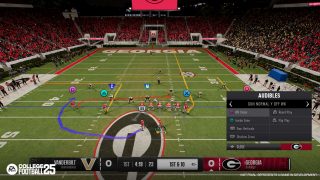
Note the walk to the line is back and officials are spotting the ball. So the heart pumping moment of whether or not you will be able to snap the ball in time is back!
REAL TIME COACHING
Making its debut in this year's edition, the Real Time Coaching (RTC) feature is an adaptive coaching engine designed to authentically enhance both offensive and defensive CPU gameplay.
In this RTC engine, coaching aggressiveness possesses unique adaptive adjustment levels. This means that different coaches will react and adapt differently to successful run or pass games, thus creating a more authentic, dynamic, and unpredictable game environment.
Additionally, the AI now has access to the full range of adjustments, just like a human player would make. As a result, you can expect to see teams employ an array of adjustments such as shade techniques, showing blitz, run commits, QB contains, and Spy's, to name just a few situational adjustments.
The AI will also recognize and adapt to your offense personnel. For instance, if you're dominating a team with the inside zone out of 11 personnel, you'll notice the CPU tweaking their defensive line, providing a different look to potentially alter your play call. If you're having significant success on the ground, you may find some teams loading the box earlier than others.
Furthermore, the AI is designed to be aware of your players' ratings and abilities. If you have an elite wide out, some teams might double him from the jump or match him with their top corner. This is an example of the 'Best on Best' matchup strategy enabled by RTC.
The defensive AI is also capable of disguising coverage, adding another layer of challenge to the gameplay. Situational adjustments are another key feature of this new engine. Despite being in its first year, this engine significantly enhances pre-snap adjustment chess matches. For example, in scenarios where you're inside the 10 with man coverage, expect to see more press and inside shade technique forcing the ball out and over the top.
Another example of situational adjustments is when the opposition is leading by three scores late in the game. In this case, you'll notice them keeping the ball inside and tackling conservatively to keep the clock ticking.
In conclusion, this is just the first year of the implementation of this foundational feature. The groundwork for the ultimate strategic experience has been laid, and we can't wait to see where it goes from here.
IN THE TRENCHES
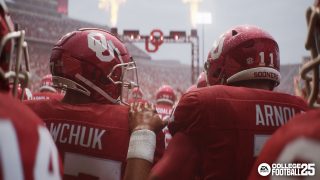
All of the features mentioned above are great, but we know that Championships are won in the trenches. If your offensive line can’t hold up, nothing else matters. This year, our primary emphasis upfront was showing what true ‘game wreckers’ look and feel like inside. There is more to the game than just sacking the quarterback. Great defensive linemen can dominate inside just by using their size and strength advantage to create constant pressures and manipulating the pocket.
A new pass protection mechanic has been added which provides 6 pass protection targeting schemes. These schemes allow players to have increased control over matchups. Through user interface matchup lines, players can now see who is targeting who, and indicators will show unblocked defenders. Additionally, the pocket formation on pass plays has been improved to enhance the overall gameplay.
To maintain the flow of momentum in blocking interactions, 400 animations have been added. These animations not only cover open field blocking but also extend to pass blocking and run blocking point of attack/engagements. This helps deliver an aggressive and powerful experience in the trenches, akin to what is played out in real life on Saturdays.
The pass rush and run stopping power of the defense have also seen a significant upgrade. The ability for pass rushers to play more pass rush moves and more often has been increased. This improvement is backed with new animations. Similarly, defenders now have an increased ability to play more shed moves in the run game, also supported with new animations. These upgrades aim to enhance the activity in the trenches, making it more lifelike.
Another key focus of development was the targeting systems for the fundamental blocking schemes such as inside and outside zones. The aim here is to increase a user's ability to predict the outcome of targeting and be confident that the defenders who need to get picked up will get targeted.
IT’S POURING OUT HERE
Throwing or handling a wet football is challenging and a fundamental component of the game. We have introduced several changes to gameplay that make the experience more immersive and realistically difficult. The weather now plays a significant role in influencing the outcome of the game, and the effects are far from subtle.
Let's first touch on player movement. Harsh weather conditions affect the movement of your players. It’s challenging to plant and cut in these conditions and this will be the first thing you feel.
The passing game faces considerable impact when playing under harsh weather conditions as well. Players will notice wobbly passes, impacted pass accuracy and throw power are some of the other gameplay elements affected by the weather.
The chances of increased drops and fumbles also rise under adverse weather conditions. The ball becomes slippery and harder to hold onto, increasing the risk of turnovers. This aspect means that players will have to be extra cautious while handling the ball while using the RB/R1 cover ball mechanic. This is not a one way street however, weather will also make base wrap and dive tackling a bit more challenging as well.
Lastly, weather impacts special teams. You will feel hits to your kick power and accuracy. Kicking the ball in heavy rain or snow can drastically alter its trajectory and distance, making field goals and punts a challenging task.
IT’S THE LITTLE THINGS
- You may have noticed it in the trailer, but in case you didn't, new one-foot sideline catch animations have been added. You can access these using the 'Possession Catch' near the sideline.
- New 'walk to the line' animations have been added. Now, all players on each side of the ball will walk to the line following a play call. The timing of when you can snap should still feel quick, while still giving the opposing team time for adjustments.
- Defensive 'Pursuit' has been refreshed in College to represent the wide range of players' abilities in real life to track the ball carrier in space. A player's 'Pursuit' rating is key in this aspect.
- Playmaker - A fan favorite, the Playmaker mechanic (RS on Pass Plays), has been revamped for increased responsiveness and control.
- Play Action - When Play Action is called in "run situations" such as first down, or less than three yards to the first down, the effects on run fit defenders are now amplified
IT’S GOOD!
Whether the kick was ‘Wide Right’ in ‘91 or a chip shot is down the middle to win the 2010 National Championship, the kicker in college football plays a vital role that is often overlooked until the game is on the line. This year, this role is given the love it deserves, with the introduction of a new and intuitive new kicking mechanic that truly refreshes the kicking game.
HOW DOES IT WORK
The distance of the kick, along with the kicker's ratings, decide the green and yellow regions of the meter. This means that longer kicks with lower-rated kickers will have smaller green zones, making the kick more challenging. It adds an element of strategy to your game, as you need to consider your kicker's ability before making a long-distance attempt.
The speed of the ball moving side to side on the accuracy meter is also based on the distance of the kick. Simply the further the kick, the faster the ball moves, once again increasing the level of difficulty for long-range attempts.
As the ball is moving side to side, your goal is to lock the ball into the green portion of the meter by pressing the A/X button. Once that's locked in, you'll see the power meter fill up. To achieve maximum power, you'll need to release the A/X button right before the red portion of the meter. Timing is key, and the excitement of nailing the perfect kick is a thrill that's hard to match.
If you miss to the right of the middle of the accuracy meter, the ball will veer right, and vice versa if you miss to the left. This mechanic makes accuracy just as important as power, reflecting the real-life pressures that kickers face.
Lastly, hitting in the red represents an over kick. This could result in varied outcomes in terms of inaccuracies, making it a risky move. Over-kicking could potentially give you the distance you need, but at the potential cost of missing the goal posts entirely.
SWAG OUT
We wanted to put the post play creativity in your hands. We understand how much self expression adds to the thrilling plays and moments you create, and we want you to celebrate the way you want EVERY TIME you score or make a big play. Welcome to our new celebration system.
This year, you now have the choice from a variety of 20 different touchdown celebrations, four interception celebrations, and four first down celebrations.
So, how does it work? It's simple. When you score, you can press in one of four directions on the Right Stick (RS). If you want to take it up a notch, you can combo the RS with either the Left Bumper/Left Trigger (LB/LT) or Right Bumper/Right Trigger (RB/RT). This system allows you to swag out, get pumped, or taunt the crowd your way.
Have fun exploring all the options, or pause the game and check out a full list in the menu.
With this feature, you can do everything from striking the iconic Heisman pose to taunting the opposing crowd with your hand to your ear. We've ensured that all celebrations are within the range of what you see on Saturdays – nothing too over the top, keeping everything true to the spirit of college football. Enjoy!
VICTORY FORMATION
Welcome to 'Victory Formation.' We all know that feeling - a pivotal run on 3rd or 4th and short, the opposing team is out of timeouts, and our running back gets just enough to seal the game. As long as football games have existed, after this game-clinching moment, you've had to sit under the center for 30+ seconds just to take three consecutive kneel downs. Well, I'm happy to say those days are over!
This year, as soon as the game is mathematically over, just take a knee. Players will come onto the field, and we will simulate the following kneel downs. Not only does this feel like Saturday, but it can also get you back into your next game, wherever that may be!
TIME TO GET ON THE FIELD…
And just like that, the blog has come to an end. The level of dedication and commitment from our team in delivering EA Sports College Football 25 makes me proud and fortunate to be a part of. The passion of this team has been the driving force behind this game, and it is a sentiment that is visibly shown as soon as you launch the game. With the amount of features and detail in this Campus Huddle article, you understand this game is not fast following anything, but instead, it is trailblazing a new path with its fundamental and forward-thinking features and approach in our American Football space.
One of our team mottos this year was, “This is THEIR game.” And we stand by that.
Throughout the development process, we've reviewed thousands of wishlists, tweets, and forum posts regarding your hopes for this game. There’s a ton here, and we did not get to EVERYTHING, but I can tell you that the proverbial Trojan Sword has been planted at midfield, signifying our dedication to this project. It's been an awesome journey thus far, and I am incredibly excited about where we go from here. Great work, Team!
We will be back with more on the Presentation of College Football and our other modes coming later this summer.
Until next time…
WinnersWin and I’m out!
- Scott O’Gallagher and the entire dev team

College Football 25 launches worldwide on July 19th, 2024. Pre-order the Deluxe Edition or the EA SPORTS™ MVP Bundle and play 3 days early. Conditions and restrictions apply. See disclaimers for details. Stay in the conversation by following us on Facebook, Twitter, Instagram, YouTube, and Answers HQ.


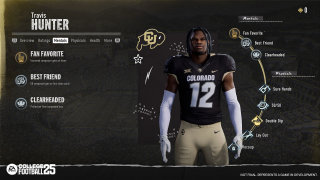




No comments